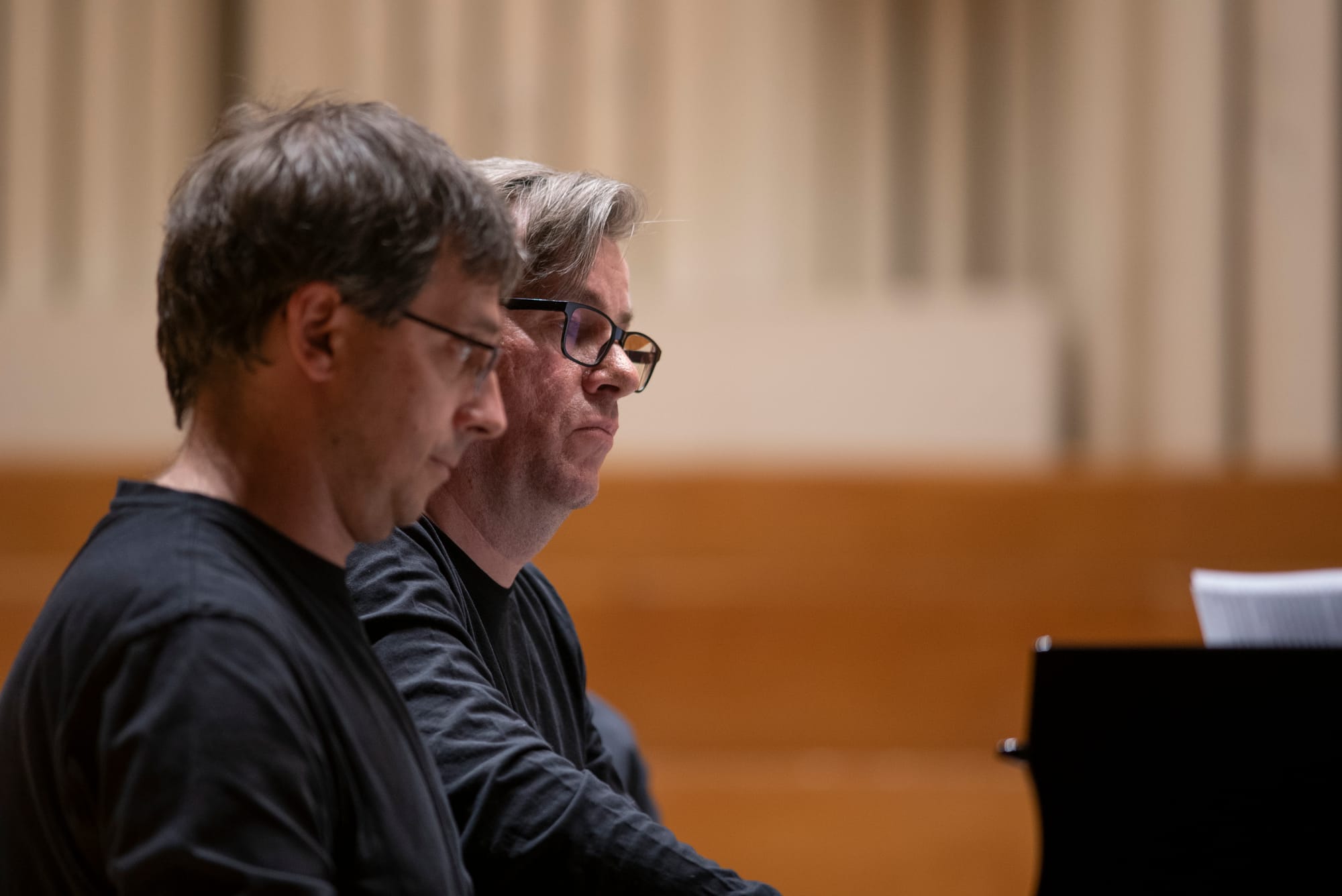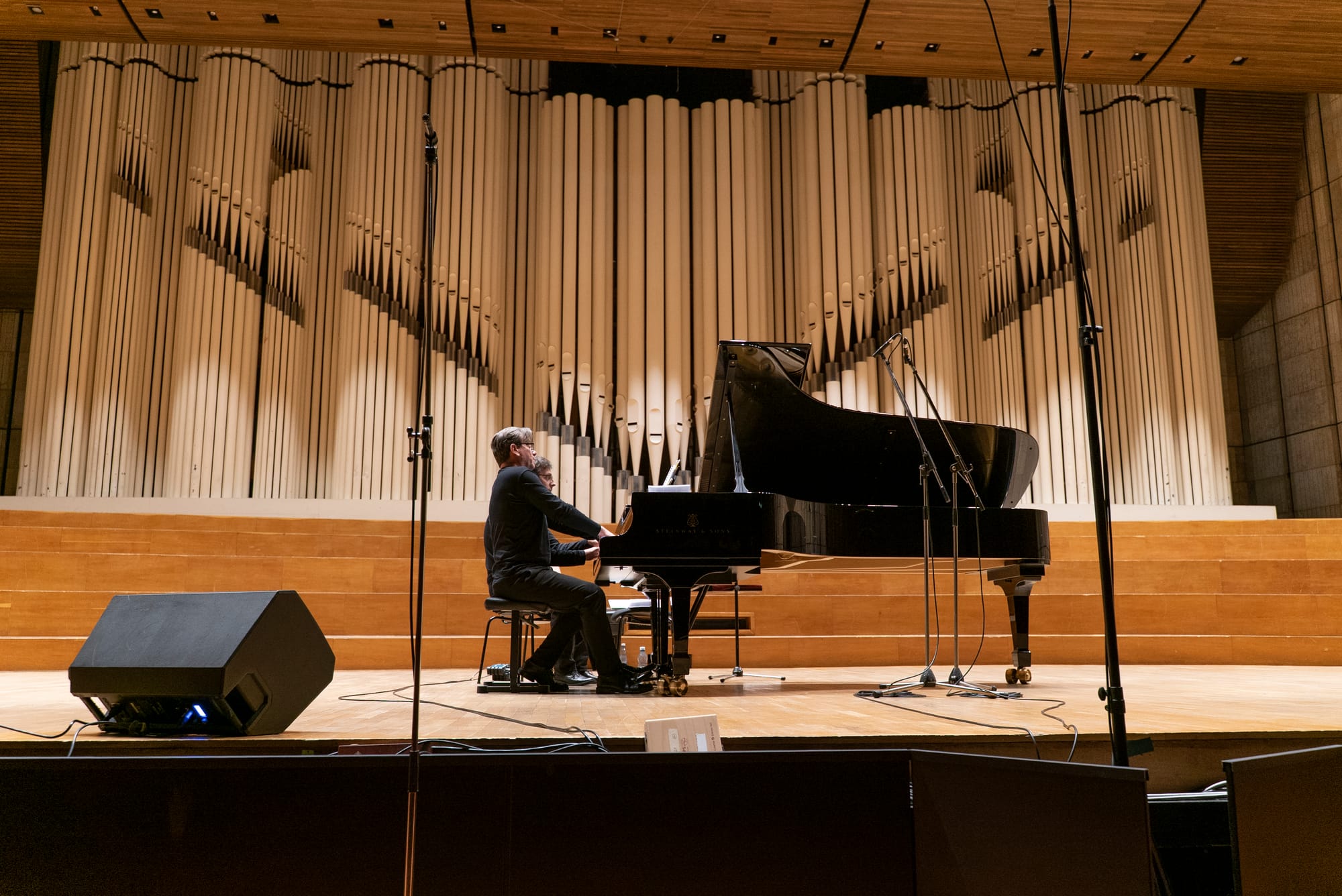Morceaux en forme de poire: Hommage à Erik Satie from Ensemble Ricercata
A fascinating concert, beautifully presented and performed

Ensemble Ricercata (Ivan Šiller, Tomáš Boroš, piano). Large Concert Studio of Slovak Radio, Bratislava, 14.06.2025
Satie Trois morceaux en forme de poire
James Tenney Three Pages in the Shape of a Pear (in celebration of Erik Satie)
Hauke Harder Birnen, Bohnen und Speck
Tomáš Boroš Morceaux - Formes - Poires (Erik Satie's harmony)
Miroslav Pudlák Erixations
Robert Kolá√ The New House (for Erik)
Vít Zouhar La maison de quatre cheminées I
Marek Plaček Shaky Pears Remix
Peter Zagar Un poire supplémentaire
Maarten Nellestijn Souris mécanique
Piet-Jan van Rossum Messe très courte
David Dramm Seconda Prima
Daniel Matej I Tried Them And They Were All Rotten
Petr Cigler Horizontal Pleasures
František Chaloupka La chaconne aléatoire (Hommage à Erik Satie)
Martin Burlas Freezing
Michal Nejtek Pralenir
Dating from 1903, Erik Satie's Trois pièces en forme de poire are typical of that composer's enigmatic, pithy mode of utterance. In a typical moment of eccentricity, there are actually seven movements, starting with “Manière de Commencement,” delivered charmingly here by Šiller and Boroš. The initial two movements are preludial to the three morceaux themselves; the final two are postludal. Šiller and Boroš toss the theme of the “Prolongation du même” between each other perfectly (the tempo, too, is superbly chosen: “Au pas”; walking pace). Both of these movements are based on early pieces, the “Manière du Commencement” based on an unpublished Gnossienne as part of the incidental music to Paladin's play Le Rio Soleil de plomb (c. 1900), and the march based on the unfinished song Le Roi Soleil du plomb. The mock grandeur of Šiller and Boroš's perfomance is perfect.
So to the pear-like ones themselves. The first piece is the only one that is entirely original. Pianissimo to forte juxtapositions are well-marked here, while Šiller and Boroš's sure sense of pulse ensures success. The second is marked “enlevé” (detached) and is based on two of Satie's cabaret songs, its calmer quiet section absolutely beautiful. The pedalling is beautifully managed by Šiller (who was playing secondo). For the “final” piece, the marking is “brutal” (brutally); this includes music for a draft for the Dances de travers from the Pièces froides (you can hear Aldo Ciccolini playing the complete set in his 1966 recoding here). Certainly there is something of an equivalence of worlds between the “pear” piece and the “cold” one; the capricious, quixotic nature of the final official “Pièce en forme de poire” is well projected here, the ending properly outrageous. .
After that ending, some calm: “En plus” (What's More), actually a transcription of Satie's Danse for chamber orchestra of 1890, the primo line given with superb cantabile, the whole deliciously fragile. The final “Redite” (rehash) uses material from music for Le Boeuf Angora and some popular waltzes by Satie.
There is something heartwarming about the true chamber playing on display here (for all of his excellence, one has to remember that Aldo Ciccolini's recording of this is that pianist overdubbed on himself).
James Tenney's Three Pages in the Shape of a Pear in celebration of Erik Satie comes from the pen of a composer who was a pupil of John Cage. The tappings of his piece las only a minute. Written in 1995, the instrumentation is given as“for piano (or ...)” and various realisations are therefore available: try Bernard Chamayou (prepared piano, very much in the manner of Cage) or Dustin Donahue (vibraphone). Tenney is a fascinating composer: try his Spectrum Pieces as a next port of call (here's a link to the Barton Workshop performances).
Hauke Harder's Birnen, Bohnen und Speck (Pears, Beans and Bacon) is a set of two pieces for piano three hands: "Drei Birnen in Form eines Stücks (für Erik Satie)” and “Drei Hände für Ernstalbrecht (fùr Ernstalbrecht Stiebler)". The composer speaks about how both Satie and Stiebler (1934-2024) helped him appreciate the interval of a tritone; pears, beans and bacon are the composer's favourite North German foods (the composer claims his “pear“ is shaped more like an apple). The two pieces give a sense of stasis (preserved pears, perhaps), a sense of held-breath stillness perfectly captured here; Harder's intervallic sensitivity is everywhere apparent, creating maximum expressivity.via minimal means.
Born in 1955 in Bratislava composer Martin Burlas enjoyed success when his opera The Coma was staged at Slovak National Opera in the 2007/8 season. Here, he offers Morceaux-Formes-Poires (Erik Satie's harmony). The piece is meditative, somehow ancient and modern at once, while Miroslav Pulák's Erixations is a clear pun, musically and verbally, on the repetitions in Satie's 1893 Vexations: the timings are obviously very different (Vexations can be notoriously long), but there is the same sense of 'niggling'.
Robert Kolář takes a motif from the third of Satie's Morceaux en forme de poire, and pairs it (no homonymic pun intended) with Ronan Martin's take on Iain Macdonald's The New House in St Peter's - this one:
... and, as the composer points out,
coincidentally, the first four notes of the Scottish air´s B-section are identical with those of Satie´s riff, sharing even the same tonality...
Related to housing, Vit Zouhar offers up La maison des quatre cheminées I, its title a reference o Constanin Bancusi's Le Maison d'Accueil, known as "aux quatre cheminées" and the residence of Erik Satie. See this article on the Centre Pompidou's website for more. His piece is charmingly mysterious, or perhaps mysteriously charming
Marek Plaček is a name new to me, his Shaky Pears Remix an exercise in Minimalism. Peter Zagar's Une poire supplémentaire dates from 1995 (first performed by John Tilbury in the summer of that year, in Slovakia). Here's Zagar's extraordinarily haunting clarinet quintet from the following year:
I love the idea of a mechanical sigh, and that's exactly what Maarten Nellestijn offers, Souris mécanique, perfectly Satie-esque and reformed with buckets of character by Šiller and Boroš. As a bonus, here's Nellestijn's Four Elements:
Ivan Šiller has released a full disc of the music of Jan van Rossum previously on VENI Ensemble's own label. Here, we are offered Messe très courte, which comprises only an entrance and an exit ("entrée" and "sortie"). Perhaps the shadow of Messiaen hovers over this (harmonically, not just over the idea of a liturgical Mass). Messe très courte feels nocturnal, perhaps a Vespers.
David Dramm offers Seconda Prima; presumably the players do what it says on the tin, but it is full of poignant harmonies.
Daniel Matej's music is very much a known quantity: subscribers of the American magazine Fanfare can access my review of Matej's CD with VENI Ensemble in issue 48:5. A pupil of the great Louis Andriessen (1939-2021), Matej writes much that is challenging, but rewarding. Last Time I heard I Tried Them And They Were Rotten (from ... morceaux en forme de poire) I referenced Cardew as well as the Satie originator. That was in a version for piccolo and bass clarinet; the black-and-white colours of the piano emphasise the processes at work here. The superb performance by Šiller and Boroš carries much character, as well as weight.

Petr Cígler (born 1978) contributes Horizontal Pleasure, a piece that offers a sense of conrtolled exuberance (listen to the snippet from the first movement of hs Horn Concerto here to experience exuberance writ large). Here, he concentrates on the energetic potentialities of a.repeated note before softening to chordal passages with a consonant bent; we hear the return of the opening, no repeated dyads, as more urgent before a softening allows the repeated note, still sounding on and on, to find some measure of peace.
František Chaloupka's studies took him to Ostrava, Brno, and The Hague. He has worked especially with the composer/conductor Péter Eötvös, whose recording of Chaloupka's Mašin Gun: Seven Rituals for the Purging of the Caech lands from the spirit of Ccommunism has been recorded by Eötvös and Ensemble Modern: you can find that on iDagio, or there is a Chaloupka YouTube playlist here. His Le chaconne aléatoire (Hommage à Erik Satie) is a study in layering; it combines the traditional suture of a chaconne with aleatoric (chance) methods; the repeating chaconne bass is therefore available for change. Satie is invoked via the playful aspect of the piece, and a sense of absurdity. The performance is markedly exciting; a reflection, perhaps, of the in-the-moment chance operations.
Martin Burlas's Freezing does indeed suggest a place of cold, and yet a place of nostalgic memories in the plainive melody. A piece of dualities held simultaneously, therefore.
Finally, Czech composer Michal Nejtek (born 1971, Litoměřice: work list) offers Pralentir, a schizophrenic piece that moves swiftly from the jazz of its opening to a more poinllllist Weltanschauung and thence to ambient electronics with piano. he whole is like a procession of styles within three minutes. The title seems to refer to Tollkein and The Lord of the Rings.
A fascinating concert, beautifully presented and performed. You can get a flavour of the concert from this video:
